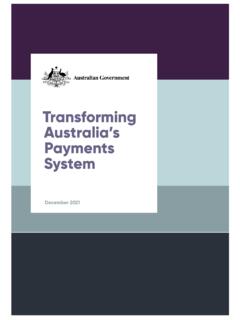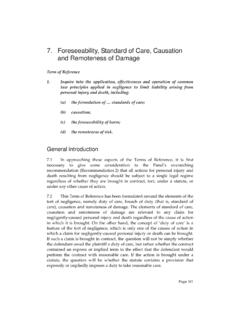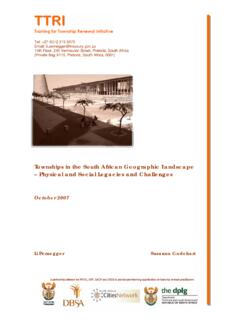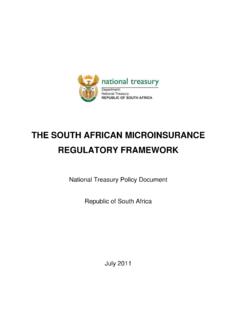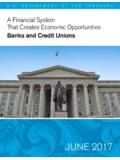Transcription of Payments system review - treasury.gov.au
1 Payments system reviewFrom system to ecosystemJune 2021 Payments system review From system to ecosystem June 2021 ISBN: 978-1-925832-35-8 Commonwealth of Australia 2021 This publication is available for your use under a Creative Commons Attribution Australia licence, with the exception of the Commonwealth Coat of Arms, the treasury logo, photographs, images, signatures and where otherwise stated. The full licence terms are available from Use of treasury material under a Creative Commons Attribution Australia licence requires you to attribute the work (but not in any way that suggests that the treasury endorses you or your use of the work). treasury material used as supplied . Provided you have not modified or transformed treasury material in any way including, for example, by changing the treasury text; calculating percentage changes; graphing or charting data; or deriving new statistics from published treasury statistics then treasury prefers the following attribution: Source: The Australian Government the treasury Derivative material If you have modified or transformed treasury material, or derived new material from those of the treasury in any way, then treasury prefers the following attribution: Based on The Australian Government the treasury data Use of the Coat of Arms The terms under which the Coat of Arms can be used are set out on the Department of the Prime Minister and Cabinet website (see ).
2 Other uses Enquiries regarding this licence and any other use of this document are welcome at: Manager Media and Speeches Unit The treasury Langton Crescent Parkes ACT 2600 Email: CONTENTS Foreword .. iv Executive summary .. vii What was the review asked to do? .. vii Overview of findings and recommendations .. vii Summary of recommendations .. xi Part 1: The Payments ecosystem ..1 What is a payment? .. 1 A network of arrangements .. 1 From system to ecosystem .. 3 Part 2: Regulating Payments ..7 Why do we regulate Payments ? .. 7 Australia s regulatory architecture ..10 Part 3: Evaluating the regulatory architecture .. 14 Principles for the regulatory architecture ..14 Evaluating the regulatory architecture ..19 Part 4: Preparing for the future.
3 43 An integrated regulatory architecture ..43 A modernised regulatory framework ..53 Better aligning regulator approaches ..73 Empowering consumers and businesses with Payments Modernising government Payments ..77 Part 5: Addressing pressing challenges .. 79 New technology and business models ..80 New forms of money ..82 Financial inclusion ..86 Developments in the data ecosystem ..90 International interoperability ..91 Appendix .. 93 Terms of Reference ..93 Consultation process ..94 Glossary ..95 Key acronyms ..98 Payments system review : From system to ecosystem iv Foreword The future is set to fundamentally reshape the way we make Payments and the way organisations provide payment services. Payments are part of everyday life.
4 In purchasing groceries at the supermarket, receiving a salary, or sending money to a friend, we all use a payment system that has kept our money safe, and made transfers of value efficient and effective. But new technologies, business models, participants, and even new forms of money are transforming the old system , forcing it to grow and adapt. The emergence of this new ecosystem has already begun, with developments such as digital wallets, buy-now pay-later and cryptocurrencies showing the way. And there will be many more to come. The evolution of the nature and methods for Payments will provide convenience for consumers and opportunities for businesses, but it will also increase complexity and risk. Our regulatory architecture therefore needs to support the payment system through this transformation, so that Australians can enjoy the benefits with confidence.
5 This review has found that our regulatory architecture needs to progress in three aspects: Enhanced Payments leadership. The Government s role in providing overarching strategic direction, vision and oversight should be enhanced with new obligations and powers to protect the Payments system and to establish an inclusive, specific, and dynamic strategic plan for its development. Aligned Payments regulation. The coordination between Payments regulators should be strengthened and a functional perspective on Payments regulation implemented to improve consistency and certainty in regulatory outcomes and better align with the strategic direction. Simplified Payments licensing. The government should establish a single, integrated licensing framework for payment services that scales up with businesses as they grow, provides clear consumer protection, and facilitates transparency in access to payment systems.
6 Taking this approach with our regulatory architecture will encourage collaboration between the public sector and private sector participants to plan for new developments, respond to new challenges and improve the way that consumers and businesses are served. It should also: enable greater adoption of faster payment services by consumers and governments, broader innovation, and improved engagement with economy-wide Payments challenges support the creation of new digital infrastructure, allowing our Payments system to better integrate with the digital economy and innovations like the consumer data right and digital identification Foreword v assist Australian businesses who participate in Payments to offer their services internationally ensure Australian customers can safely benefit from the payment services developed overseas.
7 We cannot delay. It has been more than twenty years since Australia updated its regulatory architecture for Payments , and many other countries have already modernised their approaches to the benefit of their consumers and businesses. Although what we have has served us well, it is now time for an upgrade. A world-class digital economy needs a world class Payments ecosystem. It has been a distinct privilege to lead this inquiry. I am very grateful to the many people who took the time to contribute submissions and (virtually) meet with me. Payments can be an arcane area of great complexity and many experts who have invaluable and irreplaceable expertise and experience have devoted considerable time and effort to assisting me with this review . Finally, I want to extend my warmest thanks to the professional, patient, and tireless staff of my secretariat, whose support and hard work made conducting this review possible.
8 Scott Farrell Executive summary What was the review asked to do? The Prime Minister, the Hon Scott Morrison MP and the Treasurer, the Hon Josh Frydenberg MP announced on 29 September 2020 the JobMaker Digital Business Plan, which included a suite of measures designed to accelerate Australia s recovery from the economic impacts of the COVID-19 pandemic. A key element of this package included reviewing the regulatory architecture of the Australian Payments system . The Payments system plays a key role in the Australian economy. It facilitates Australia s economic activity by providing a safe, efficient and effective way for Australians to exchange money for goods and services. Over time, the Payments system has expanded in size and complexity to such an extent that it should be thought of as the Payments ecosystem.
9 Technology has enabled new methods of payment and has led to the entry of a range of new providers offering new services using traditional payment infrastructures. Consumers are also adopting digital payment methods in record numbers, further accelerating the transformation in the Payments ecosystem towards greater digitalisation. Despite significant changes to the Payments ecosystem, the regulatory architecture, which includes a range of regulatory agencies, industry bodies and the government, has remained relatively unchanged for over two decades. It is vital that the regulatory architecture supporting our Payments system can continue to instil confidence and protect the security of the system while promoting innovation and competition in a way that enhances the user experience.
10 The review was asked to investigate whether the regulatory architecture of the Australian Payments system remains fit-for-purpose and responsive to advances in Payments technology and changes in consumer demand. This includes investigating whether the regulatory framework adequately accommodates new and innovative services and its effectiveness in facilitating the implementation of government policy. The review was also tasked with examining how the regulatory architecture could create more productivity-enhancing innovation and competition, increase the understanding of alternative payment methods, and ensure government agencies are well-placed to take advantage of new payment functionalities to enhance service delivery. Overview of findings and recommendations Payments have evolved well beyond the systems that existed at the turn of the new millennium when the current regulatory architecture was established.





